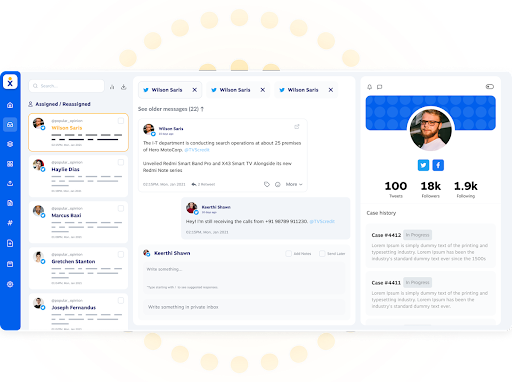There’s a huge trust gap in businesses today.
One PwC study found that despite nearly 84% of business executives thinking customers highly trust their company, only 27% of them would agree. Trust is nearly guaranteed to build a supportive community around your brand and increase the rate at which customers come back to you time and again.
One quick measure of that is the number of reviews. Another measure is their star ratings. What else can you do to grow your business?
Integrating real customer feedback throughout your marketing strategy helps to shorten sales cycles, lower acquisition costs, and grow revenue.
So, let’s look at some of the most effective tactics to grow brand trust and sales.
What Is Review Marketing?
Word-of-mouth marketing has existed for as long as humans have been talking. If something is just that good, you’ll want to tell someone about it. People have always made personal recommendations to their friends, colleagues, and family.
The internet, however, has increased the reach and impact of word-of-mouth marketing. Customer reviews and referrals are valuable social proof that your brand and its offerings are credible and worth the money.

What consumers choose to buy is significantly influenced by reviews. Harvard Business Review uncovered that for every one-star increase a business gets on Yelp, it increases revenue by up to 9%. Positive reviews confirm the dependability and quality of a product or service. On the other hand, negative reviews frequently lead to distrust or deter clients.
Review marketing places a major emphasis on managing and maximizing the impact of these reviews to promote your business’s growth. And to some degree, they influence search engine rankings, too.
That means tactfully adding product reviews to product pages, email marketing campaigns, and throughout your homepage.
Actively managing customer reviews should be a cornerstone of your marketing strategy to improve a brand’s reputation, foster consumer trust, and sway purchasing decisions. It entails actively looking for, gathering, and marketing positive reviews from clients who have previously used your product or service.
How to Build a Review Marketing Program
Developing a review marketing strategy entails targeting channels where prospects discover and compare your product or service. Considering each review as a venue to build trust and credibility in your brand is crucial.
If you’re building a review marketing program from scratch, there are several tips to keep in mind.
1. Create a dedicated channel for reviews
Make it as easy as possible for your customers to leave reviews. Whether it’s a specific section on your website, a social media page, a third-party review site, or all of the above, ensure that your customers know where they can share their experiences.
Ideally, invite customer feedback through a review management tool or customer survey. From there, you can dedicate personalized customer support to helping those in need.
2. Encourage reviews
Don’t shy away from asking your customers for reviews. You can do this through follow-up emails after a sale or even with in-store signage reminding customers to leave a review.
Give it some time. It’s best to reach out several days after the sale to ensure customers are fully satisfied and have a perspective to share in an online review.
3. Respond to reviews
Acknowledging positive and negative reviews with a personal response is standard practice. Thank your customers for their positive feedback and address any issues brought up in negative reviews.
People have taken the time to leave their feedback — make sure you acknowledge their efforts since both types of reviews can help in the long run.
Related: How To Respond To Positive Reviews: Tips, Strategies, & Templates
4. Get permission
User-generated content (UGC) isn’t just something you can use without telling customers. It could upset an otherwise happy customer or potentially invite additional legal exposure.
If you intend to use a customer’s review or photo for marketing and sales purposes, you should get their consent first. This is where a photo release agreement can help. Here’s a free template to try — but check with your legal counsel first.
Additionally, don’t change the contents of their review in a material way unless they say it’s okay. Doing so could fall outside of the FTC’s Endorsement Guidelines.
This point isn’t to scare you — it’s to protect you so you can continue to use your customer reviews throughout your digital marketing.
5. Use reviews in your marketing efforts
Highlight positive reviews in your marketing materials. This reinforces your brand’s quality and shows potential customers you value feedback.
Consider the tactic of highlighting an unjust negative review. For instance, someone complaining about Shelby GT’s fuel economy could resonate with the company’s ideal customer.
Clever ways to use reviews for marketing:
- Display ads
- Lobby signage
- Landing pages
- Email signatures
- Customer case studies
- Demo thank-you pages
- Drip marketing sequences
- Paid social media campaign
6. Act on review sentiment
A core function of a review marketing strategy is to act on all customer feedback, whether positive or negative reviews. Reviews are a goldmine of information and messaging; be sure to use them to improve your products, services, and customer experiences.
With that said, it’s impossible to satisfy everyone. Unfit customers are a part of doing business. Never fear. How you handle negative reviews can still positively impact how people view your brand.
Related: Review Management: A Comprehensive Guide to Maximizing Your Online Reputation
More Ways to Elevate Brand Trust
Make it easy to find you
Ensure your brand’s presence on top review websites like Yelp, Google, TripAdvisor, Amazon, and Facebook. Claim your business online and describe your products, services, and what new customers need to know.
Most importantly, keep your business profile consistent and updated across all platforms. Use reviews to optimize your SEO strategy and online reputation.
Feature raving fans on social media
Consider sharing your strongest testimonials across social media in creative and compelling campaigns.
We recommend gaining permission to use a customer’s name and likeness for marketing purposes. Their enthusiasm and authenticity will help your business stand out. These assets also make for excellent creative images in social media marketing campaigns.
Use a professional review management tool
It’s incredibly time-consuming to check and follow up on a half dozen review sites. Plus, each review acts as a customer request of some kind that needs human intervention.

A review management tool like Nextiva streamlines the workflow for your team.
Should positive reviews go to a marketing member to personally thank clients and send them a $10 gift card? Maybe you want to instantly alert your contact center management team when a bad review gets posted.
Either way, you can automate the handling and care in a scalable, warm manner.

Reviews are influential in customers’ decision-making process. Track metrics such as reviews’ number, quality, and sentiment to refine your strategies. Use analytics to identify trends in feedback and optimize your marketing campaigns. The goal is to create a feedback loop that improves your brand’s reputation and sales.
Related: What Is a Contact Center? Definition, Features, and Uses
Leverage the Voice of the Customer to Grow Faster
No marketing plan should leave out review marketing. It’s a transformative approach to boosting your brand’s reputation and strengthening your content marketing effectiveness.
Likewise, reputation management requires a consistent effort to understand your audience, adapt to their needs, and deliver value across all marketing channels.
With reviews, you can build authentic relationships with your customers. Social proof boosts conversion rates and customer retention. Remember that building brand trust and increasing sales is an ongoing optimization process that works alongside your other digital marketing efforts.
Not all tactics will be equally effective for every business, so monitoring your results and adjusting your strategy is important.

















 Marketing & Sales
Marketing & Sales 








